Bennemann K.H., Ketterson J.B. Superconductivity: Volume 1: Conventional and Unconventional Superconductors; Volume 2: Novel Superconductors
Подождите немного. Документ загружается.


1160 M. Lang and J. M¨uller
Fig. 20.4. Schematic view of the relative orientations of the
ethylene endgroups [(CH
2
)
2
] of the ET molecule. The right
side shows the view along the long axis of the molecule
structure consists of stacks arranged in a herring-
bone pattern. The ET molecules are connected via
S ···S contacts being shorter than the sum of the
van-der-Waals radii of 3.6Å.The ˇ-type packing is
reminiscentof thestacking arrangementfound in the
Bechgaard salts.However,the smaller inter-stack dis-
tances in ˇ-(ET)
2
I
3
lead to a more two-dimensional
electronic structure.The -phase is unique in that it
does not consist of interacting stacks but rather ofin-
teracting dimers formed by two face-to-face aligned
ET molecules. Adjacent dimers are arranged almost
orthogonal to each other so that the in tra-andinter-
dimer interactions are of thesamesize.This resultsin
a quasi-2D electronic structurewith a small in-plane
anisotropy. The -type compounds with polymer-
like anions are of particular interest with respect to
their superconducting properties as they exhibit the
highest transition temperatures.
In forming the crystal, apart from the ethylene
[(CH
2
)
2
] groups at the outer ends of the molecules,
the charged ET molecules C
6
S
8
[(CH
2
)
2
]
2
untwist at
their centre and become planar.As shown schemati-
cally in Fig. 20.4, the relative orientation of the outer
C−C bonds can either be parallel (eclipsed) or canted
(staggered). At high temperatures, the ethylene end-
groups become disordered due to the strong ther-
mal vibrations. Upon cooling to low temperatures,
theendgroupsadoptoneofthetwopossiblecon-
formations, depending on the anion and the crystal
structure. As will be discussed in Sect. 20.3.4 for the
-(ET)
2
X salts, disorder in the conformation of the
[(CH
2
)
2
] groups can have a severe influence on the
electronic properties in these compounds, in partic-
ular the superconductivity.
The planar C
6
S
8
skeleton of the ET molecules per-
mits a rather dense packing with a variety of possi-
ble packing arrangements.As a result,the interdimer
interaction becomes comparable to that within the
dimers giving rise to a quasi-2Delectronic structure.
Besides the intermolecular S ···S contacts, i.e. the
donor–donor interaction, the donor–acceptor cou-
plings also play an important role for the physical
properties of these multilayer systems. The latter in-
teraction is provided by electrostatic forces as a con-
sequence of the charged molecules and the hydrogen
bondsjoining between the carbonatomsat the donor
site and the sulfur, carbon or nitrogen atoms being
located at the acceptor site. The relative strength of
Table 20.1. Room-temperature crystallographic data of some (ET)
2
X superconductors including the space group SG,
lattice parameters a,b and c, unit-cell volume V,number of formular units per unit cell z as well as T
c
values. In the case
of quasi-2D (ET)
2
X salts the lattice parameter perpendicular to the conducting planes is underlined
SG a (Å) b (Å) c (Å) V (Å
3
)z T
c
(K)
(TMTSF)
2
PF
6
P
¯
1 7.297 7.711 13.522 713.14 1 1.1 (6.5 kbar)
-(ET)
2
Cu(NCS)
2
P2
1
16.248 8.440 13.124 1688 2 10.4
-(ET)
2
Cu[N(CN)
2
]Br Pnma 12.949 30.016 8.539 3317 4 11.2
-(ET)
2
Cu[N(CN)
2
]Cl Pnma 12.977 29.977 8.480 3299 4 12.8 (300 bar)
ˇ
-(ET)
2
SF
5
CH
2
CF
2
SO
3
P
¯
1 9.260 11.635 17.572 1836 2 5.3
˛-(ET)
2
NH
4
Hg(SCN)
4
P
¯
1 10.091 20.595 9.963 2008 2 1.1
-(ET)
2
I
3
P2
1
/c 16.387 8.466 12.832 1688 2 3.5
-(BETS)
2
GaCl
4
P
¯
1 16.141 18.58 6.594 1774 2 6
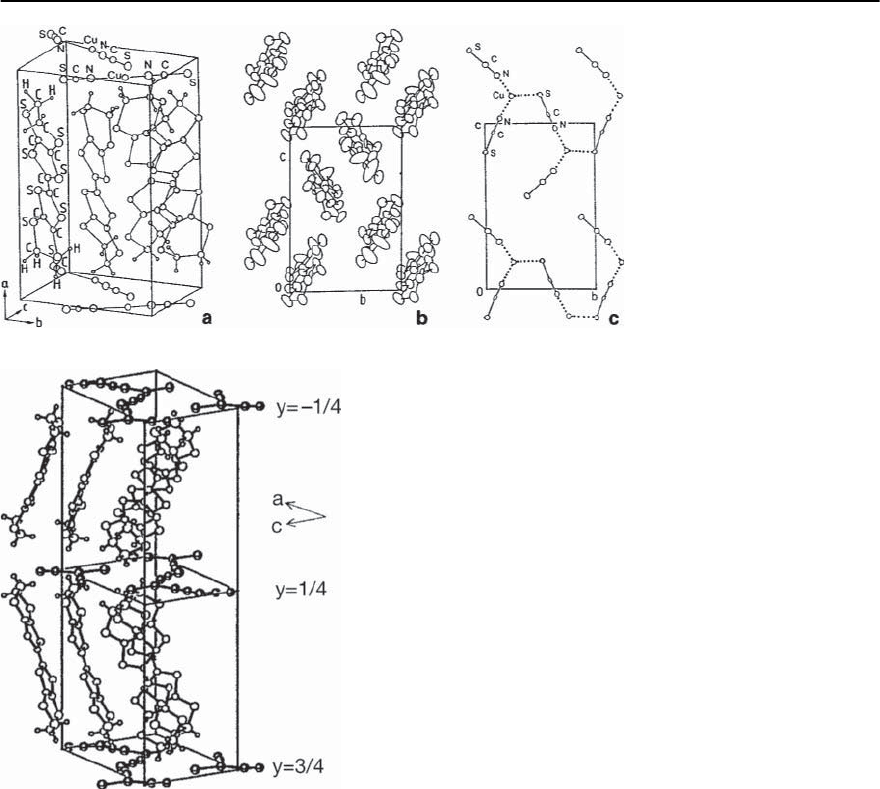
20 Organic Superconductors 1161
Fig. 20.5. (a) Crystal structure
of -(BEDT-TTF)
2
Cu(NCS)
2
.
The arrangement of the
ET molecules (b)andthe
Cu(NCS)
2
anions (c)when
viewed along the a
∗
direc-
tion, i.e. perpendicular to
the conducting planes. The
a-axis is slightly tilted from the
a
∗
-axis which is normal to the
conducting bc-plane
Fig. 20.6. Crystal structure of -(BEDT-TTF)
2
Cu[N(CN)
2
]Z, with Z = Br and Cl. Here the direction per-
pendicular to the conducting plane is the crystallographic
b-axis. The anion layers are parallel to the ac-plane at
y=−1/4, 1/4and3/4. The polymeric-like anion chains
are running along the a-direction
these different interactions, the conformational de-
grees of freedom of the ethylene groups along with
the flexibility of the molecular framework give rise
to a variety of different ET complexes [5,23].
Despite their complex crystal structure with
rather low symmetry (cf. Table 20.1) it is convenient
to think of the (ET)
2
X compounds as layeredsystems
consisting of conducting sheets formed by the ET
molecules which are intersected by more or less thick
insulating anion layers. Prime examples are the -
phase (ET)
2
X salts with X=Cu(NCS)
2
,Cu[N(CN)
2
]Br
and Cu[N(CN)
2
]Cl which are the most intensively
studied and best characterized members of this class
of materials. These compounds are of particular
interest not only because of their relatively high
superconducting transition temperatures but also
owing to certain similarities in their normal-state
and superconducting-state properties with those of
the high-temperature cuprate superconductors[4,9].
Figures20.5 and 20.6 display the crystal structures of
-(ET)
2
Cu(NCS)
2
and -(ET)
2
Cu[N(CN)
2
]Z.In both
cases the layered structure consists of conducting
planes with the characteristic -type arrangement of
the ET molecules separated by insulating anion lay-
ers. While the crystal structure of -(ET)
2
Cu(NCS)
2
has monoclinic symmetry with two dimers, i.e. two
formula units per unit cell,the -(ET)
2
Cu[N(CN)
2
]Z
salts are orthorhombic with a unit cell containing
four dimers, see Table 20.1. Due to the particular ar-
rangement of their polymeric anions, these crystals
lack a center of inversion symmetry.
Subtle changes in the intermolecular spacing or
relative orientation of the ET molecules as e.g. in-
duced by either external pressure or anion substi-
tution may significantly alter the -electron over-
lap between adjacent molecules. This can have a se-
vere influenceon theelectronic properties as demon-
strated for the -(ET)
2
Cu[N(CN)
2
]Z system for vari-
ous Z: while the compound with Z = Br is a supercon-
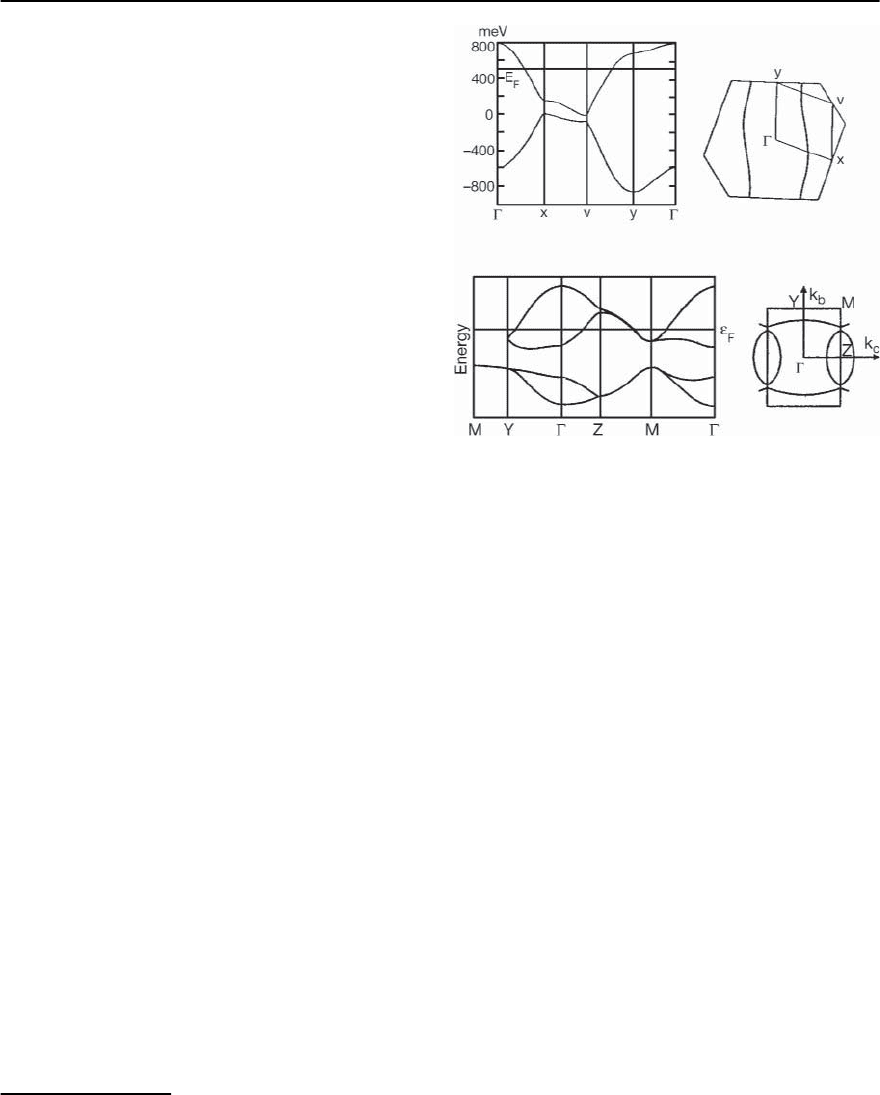
1162 M. Lang and J. M¨uller
ductor with T
c
=11.2 K [24], replacement of Br by
the slightly smaller Cl results in an antiferromagnetic
insulating ground state.On the other hand,the appli-
cation of hydrostatic pressure of only about 300 bar
drives the latter system to a superconductorwith a T
c
of 12.8 K [25–27],the highest transition temperature
found among this class of materials so far.
A new class of materials which has recently gained
considerable interest is based on the donor molecule
BETS and its combination with the discrete an-
ions MX
4
(M = Fe, Ga, In; X = Cl, Br). Two struc-
tural modifications have been found. These are the
orthorhombic -type structure (Pnma) which re-
sults in plate-like crystals and the triclinic (P
¯
1) -
type variant which grow in a needle-like manner
[28–30]. The -(BETS)
2
GaCl
4
salt is a superconduc-
tor with T
c
= 6 K [31]. Upon substituting Ga by
Fe in -(BETS)
2
Fe
x
Ga
1−x
Cl
4
superconductivity be-
comes continuously suppressed with increasing x
[32] and, for x ≥ 0.5, replaced by an antiferromag-
netic insulating ground state.
Some structural data for a selection of organic su-
perconductors are summarized in Table 20.1.
20.3 Normal-State Properties
20.3.1 Electronic Structure
As for ordinary metals, the electronic properties of
organic charge-transfer salts are determined by the
quasiparticles atthe Fermi surface (FS).
3
Theenergy-
band structures for both the quasi-1D (TM)
2
Xand
the quasi-2D (ET)
2
X salts have been calculated em-
ploying a tight-binding scheme with a few simplifi-
cations. For a comprehensive overview on the band-
structure calculations and Fermi-surface studies see
[5] and references cited therein.The calculations are
based on the assumption that the intramolecular in-
teractions are much stronger than the interactions
between adjacent molecules reducing the complex-
ity of the problem enormously. In a first step, -
and -molecular orbitals are constructed using lin-
ear combinations of atomic s and p-orbitals of the
constituentatoms.In the molecular-orbital(MO) ap-
Fig. 20.7. Calculated energy dispersion and Fermi surface
of (TMTSF)
2
X [37] (upper panel)and-(ET)
2
Cu(NCS)
2
[41,42] (lower panel)
proximation, the electrons (holes) are considered to
be spread over the whole molecule and only those
electrons (holes) near the Fermi surface in the high-
est occupied (HOMO) andlowest unoccupiedmolec-
ular orbitals (LUMO) are taken into account. Due to
the overlap between molecular orbitals of adjacent
molecules,the corresponding -electrons(holes)are
delocalized.Using available structural data,the over-
lap integrals and transfer energies can be obtained
from quantum chemistry. These are input parame-
tersfor a standardtight-binding calculationbasedon
molecular orbitals obtained by the extended H¨uckel
approximation(EHA)fromwhichthebandstructure
and Fermi surfaces are derived [23,34–36].
Based on the above approximations, Grant et
al. have calculated a model band structure for the
quasi-1D materials (TM)
2
X [37], see upper panel
of Fig. 20.7. The FS consists of two open sheets
which are slightly corrugated due to weak interac-
tions perpendicular to the stacking axis. While the
standard magnetic-quantum-oscillation studies can-
not be used for these quasi-1D metals, some im-
portant information on the FS can still be derived
3
This implies the applicability of the Fermi-liquid concept which is questionable for the most anisotropic (TM)
2
Xsalts,
see e.g. [33].

20 Organic Superconductors 1163
from angular-dependent magnetoresistance mea-
surements,see e.g.[38].Of crucial importanceare the
topological aspects of the FS, i.e. the nesting proper-
ties, and the band filling. The conduction band can
accommodate four electrons per (TM)
2
unit.Due to
the weak structural dimerization which is more pro-
nouncedin theTMTTF comparedto theTMTSF salts,
a dimerization gap splits the conduction band into
two parts. Therefore, removing one electron per unit
cell in the charge-transfer process results in a half-
filled conduction band.
The FS topology of the quasi-2D materials
has been studied in great detail employing mea-
surements of the de Haas–van Alphen (dHvA)
and Shubnikov–de Haas (SdH) effect, the angular-
dependent magnetorestistance (AMRO) and the cy-
clotron resonance, see [39,40]. These results clearly
demonstrate the presence of a well-defined Fermi
surface and quasiparticle excitations in accordance
with the Fermi-liquid theory.
The lower panel of Fig. 20.7 shows the results of
EHA band-structure calculations for the supercon-
ductor -(ET)
2
Cu(NCS)
2
.Sinceanyinterlayer elec-
tron transfer has been neglected in these calcula-
tions,the resulting FS is strictly two dimensional.De-
spite the various simplifications employed, the main
features of the so-derived FS are generally found to
be in remarkable agreement with the experimental
results [39], although a more elaborated analysis re-
veals certain details which are not adequately de-
scribed [10,43].
The four bands correspond to the four ET
molecules in the unit cell, each represented by its
HOMO.Due to the lack of a center-of-inversionsym-
metry, an energy gap opens at the Z-M zone bound-
ary.As a consequence, the FS consists of closed hole-
like quasi-2D orbits (˛-pockets) and a pair of open
quasi-1D corrugated sheets. According to a charge
transfer of one electron per pair of ET molecules,the
conduction band is three quarters filled. Due to the
strong dimerization of the ET molecules in the -
type structure,the conduction bands split up so that
the upper band becomes half filled. Band-structure
calculations based on high-temperature crystallo-
graphic data reveal FS topologies which are very sim-
ilar among the various -(ET)
2
X systems [35, 36],
except for the degeneracy of the upper two bands
along the Z-M zone boundary for the linear anion X
=I
3
.Whilethe˛-phase and -phase (ET)
2
Xsaltsstill
combine quasi-1D and quasi-2D bands, the FS of ˇ-
typesaltsisevenmoresimple.Itisofalmostcylindri-
cal shape and closed within the first Brillouin zone,
reflecting the isotropic in-plane interactions between
adjacent ET molecules.
Fermi-Surface Studies
In a magnetic field B, the transverse motion of elec-
trons becomes quantized and their allowed states in
k-space are confined to so-called Landau levels.Peri-
odic oscillationsin magnetizationandresistivityas a
functionof 1/B arise fromthe oscillatory behavior of
the density of states at the Fermi level E
F
as the Lan-
dau levels pass through the Fermi surface. From the
oscillation period (1/B) the extremal area of the FS
cross section,S
F
,perpendicular to the magnetic-field
direction can be derived [44]:
S
F
=
2e
1
(1/B)
, (20.1)
where −e is the electron charge and the Planck
constant. A quantitative description of the oscilla-
tory magnetization was given by Lifshitz and Kose-
vich [45]. According to their work, the amplitude of
theoscillationsisgivenby:
A ∝
T
√
B
exp
−
m
∗
c
T
D
m
e
B
sinh
m
∗
c
T
m
e
B
, (20.2)
where the effect on the electron spin has been ne-
glected.m
e
denotes the free electron mass and m
∗
c
the
cyclotron effective mass, =2
2
m
e
k
B
/(e)withk
B
being the Boltzmann constant.T
D
= /(2k
B
)isthe
Dingle temperature which accounts for the broaden-
ing of the Landau levels due to scattering of the elec-
trons where is the relaxation time averaged over
a cyclotron orbit. For state-of-the-art crystals of the
(ET)
2
X salts, the Dingle temperatures are usually far
below about 1 K, as e.g. T
D
∼ 0.5K as reported for
-(ET)
2
Cu(NCS)
2
[46],whichreflect the high quality
of these materials.
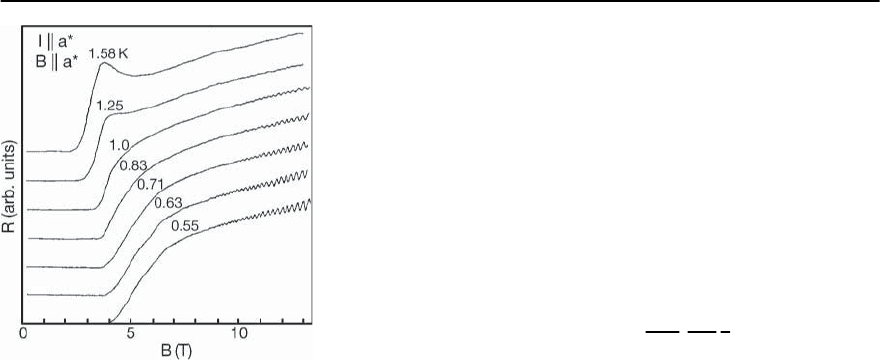
1164 M. Lang and J. M¨uller
Fig. 20.8. Magnetorestistance of -(ET)
2
Cu(NCS)
2
at dif-
ferent temperatures. Electrical current and magnetic field
were applied along the a
∗
-axis, i.e. perpendicular to the
conducting planes. Shubnikov–de Haas oscillations starts
to become visible below 1 K, taken from [41]
Figure 20.8 showsearly magnetoresistance data on
-(ET)
2
Cu(NCS)
2
[41]; see also [40] for more recent
data. At the low-field side of the data sets, the tran-
sition from the superconducting to the normal state
is visible. With increasing the field and at tempera-
tures below1 K,Subnikov–de Haas(SdH) oscillations
caused by the closed ˛-orbits of the FS are super-
imposed. As expected from the simple FS topology
(lower panel of Fig. 20.7), a single frequency accord-
ing to only one extremal orbit (˛-orbit) dominates
the oscillatory behavior at lower fields. At higher
magnetic fields, however, a second high-frequency
component becomes superimposed [47,48]. The lat-
ter correspondsto theso-calledmagnetic breakdown
effect which is due to tunneling of charge carriers
across the energy gaps at the FS. It is common to re-
fer to the magnetic-breakdown orbit which encom-
passes the whole FS as the ˇ-orbit. For a detailed
description of the FS studies on quasi-1D and quasi-
2D charge-transfer salts, see [39,40] and references
therein.
Effective Masses and Renormalization Effects
The experimentally derived effective cyclotron
masses m
∗
c
for the various (ET)
2
X salts are signifi-
cantly larger than the band masses m
b
predicted by
the above band-structure calculations, which are of
the order of the free-electron mass m
e
(see below).
For the -(ET)
2
Cu(NCS)
2
salt, for example, experi-
ments reveal m
∗
c
=(3.5 ±0.1) m
e
for the ˛-orbit and
(6.9 ±0.8) forthe magnetic-breakdown ˇ-orbit [47].
A mass enhancement of comparable size is observed
also forthe thermodynamic effectivemass m
∗
th
as de-
termined by measurements of the specific heat C(T).
For a quasi-2D material consisting ofstacks of metal-
lic planes with interlayer spacing s , the Sommerfeld
coefficient
2D
= C/T is given by:
2D
=
k
2
B
3
m
∗
th
2
1
s
. (20.3)
For -(ET)
2
Cu(NCS)
2
one finds =(23± 1) mJ/
mol K
2
[49,50] which corresponds to m
∗
th
=(4.7 ±
0.2) m
e
.Bothm
∗
c
and m
∗
th
are renormalized com-
pared to the band mass m
b
. The latter takes into
account the fact that the electrons are moving in a
periodic potential associated with the crystal lattice.
The band masses estimated from tight-binding cal-
culations and interband optical measurements are of
the order of the free electron mass: Caulfield et al.ap-
plied the effective dimer model to -(ET)
2
Cu(NCS)
2
and found m
˛
b
=0.64m
e
and m
ˇ
b
=1.27 m
e
[46]
corresponding to a width of the conduction band of
W =0.5 ∼ 0.7eV.Thesevalueshavetobecompared
with m
˛
b
=(1.72±0.05) m
e
and m
ˇ
b
=(3.05±0.1) m
e
as derived from first-principles self-consistent local-
density calculations [51]. For a discussion on the
band masses derived from band-structure calcula-
tions and their relation to the cyclotron effective
masses,see e.g. [52]. The substantial enhancement of
the cyclotron masses compared to the band masses
suggest an appreciable quasiparticle renormaliza-
tion due to many-body effects, i.e. electron–electron
and electron–phonon interactions. It has been pro-
posed that a direct tool to determine the relative
role of electron–electron correlationsin the mass en-
hancement is provided by cyclotron resonance mea-
surements [53]. According to the Kohn theorem the
effective mass determined by cyclotron resonance
experiments, m
∗
cr
, is independent of the electron–
electron interactions. As a consequence, the exper-
imental finding of m
∗
cr
≈ m
b
has been attributed to
a dominant role of the Coulomb interaction for the
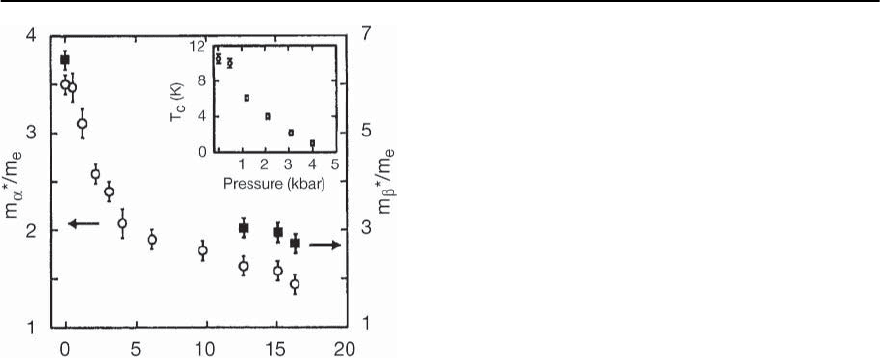
20 Organic Superconductors 1165
Fig. 20.9. Cyclotron effective masses of the ˛-orbits (open
circles, left scale)andˇ-panels (full squar es, right scale)as
a function of hydrostatic pressure for -(ET)
2
Cu(NCS)
2
.
The inset shows T
c
against pressure, taken from [46]
mass renormalization [46]. However, recent studies
on different (ET)
2
X systems along with theoretical
calculations showed that the general applicability of
the Kohn theorem for the quasi-2D organic super-
conductors is questionable, see [10,40].
On the other hand, various experiments such
as optical studies [54–59], thermal conductivity
[50,60,61] as well as inelastic neutron scattering ex-
periments [62] indicate a substantial coupling of the
charge carriers to the lattice vibrations. Taken to-
gether, it is likely that for the present molecular con-
ductors both electron–electron as well as electron–
phonon interactions are responsible for the mass-re-
normalization.
By means of pressure-dependent Shubnikov–de
Haas experiments a striking interrelation between
the suppression of superconductivity and changes
in the effective masses have been found [46]. Fig-
ure 20.9 shows the hydrostatic-pressure dependence
of the effective masses for -(ET)
2
Cu(NCS)
2
[46].As
the pressure increases,m
∗
c
rapidly decreases,an effect
which has been observed also for other (ET)
2
Xcom-
pounds [63]. Above some critical pressure of about
4 ∼ 5 kbar the rate of suppression of m
∗
c
becomes
muchweaker.Asthisisaboutthesamepressurevalue
above which superconductivity becomes completely
suppressed (see inset of Fig. 20.9), an intimate in-
terrelation between mass enhancement and super-
conductivity has been suggested [46]. This is con-
sistent with recent results of reflectivity measure-
ments which showed that the pressure dependence
of the “optical masses”, which are closely related to
the bare band masses, do not show such a crossover
behaviour [64]. Consequently, the pressure-induced
reduction of the effective cyclotron masses has to
be associated with a decrease in the strength of the
electron–electron and/or electron–phonon interac-
tions.
20.3.2 Transport and Optical Properties
Electrical Resist ivity
The organic superconductors discussed in this arti-
cle are fairly good metals at room temperature with
resistivities that vary over wide ranges depending
on the particular compound and the current direc-
tion in respect to the crystal axes. The pronounced
anisotropies found in the electrical properties are
direct manifestations of the strongly directional-
dependent overlap integrals.
For the (TM)
2
X series (cf. Fig. 20.2) one typically
finds
a
:
b
:
c
of the order of 1 : 200 : 30.000,where a
is along the stacking axis.These numbers correspond
to a ratio of the overlap integrals t
a
: t
b
: t
c
of about
10: 1: 0.1witht
a
≈ 0.1 ∼ 0.24 eV and 0.36 eV for the
TMTTF and TMTSF compounds, respectively [6,33].
Figure 20.10 compiles temperature profiles of the
resistivity for various (TM)
2
Xcompounds.Belowa
temperature T
,depending on the anion,the resistiv-
ity of the sulfur-containing (TMTTF)
2
Xcompounds
changes from a metallic-like high-temperature into
a thermally-activated low-T behavior. Upon further
cooling through T
SP
20K < T
(not shown), the
(TMTTF)
2
PF
6
salt undergoes a phase transition into
a spin-Peierls (SP)-distorted nonmagnetic ground
state, see e.g. [65] and references cited therein. With
the application of moderate pressure both T
and
T
SP
were found to decrease. By increasing the pres-
sure to p ≥ 10 kbar, the spin-Peierls ground state be-
comes replaced by an antiferromagnetic N´eel state
similar to the one found at normal conditions in
(TMTTF)
2
Br.
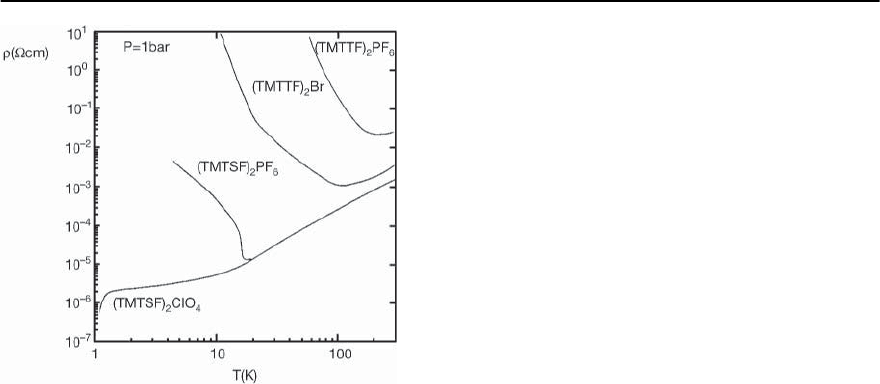
1166 M. Lang and J. M¨uller
Fig. 20.10. Resistivity vs temperature for various
(TMTTF)
2
X and (TMTSF)
2
X salts at ambient-pressure
conditions in a double-logarithmic plot [65]
In the selenium-containing (TMTSF)
2
PF
6
salt the
metallic range extends down to lower temperatures
until the sudden increase in the resistivity indicates
the transition into an insulating SDW ground state.
Above a critical pressure of about 6 kbar, the SDW
state of (TMTSF)
2
PF
6
becomes unstable giving way
to superconductivity at lower temperatures, cf. the
phase diagrams Figs. 20.22 and 20.23 in Sect. 20.3.5.
Interestingly enough, when the spin-Peierls salt
(TMTTF)
2
PF
6
is exposed to sufficiently high pres-
sure in excess of 43.5 kbar, a superconducting state
can be stabilized [66,67],which completes, for a sin-
gle compound, the sequence of ground states indi-
cated in the generic phase diagram in Fig. 20.22.
In their metallic regime the resistivity of the
(TM)
2
X salts along the most conducting direction
decreases monotonically with a power-law tempera-
ture dependence ∝ T
˛
,wheretheexponent˛,de-
pending on the temperature interval, varies between
1 and 2, see e.g. [33,68].For (TMTSF)
2
PF
6
for exam-
ple, ˛ ≈ 1.8 between 300 and 100 K and approaches
approximately 2 at lower temperatures down to the
metal-SDW transition [33]. A T
2
dependence in the
resistivity has been frequently observed not only in
the quasi-1D [68] but also for the various (ET)
2
X
salts, see below.
A question of high current interest for the present
quasi-1D conductors concerns the nature of their
low-energy excitations. Is a Fermi-liquid approach
still adequate or do we have to treat these materials
within the framework of a Tomonaga–Luttinger liq-
uid (a concept proposed for dimensionality D = 1)
[69–71]? Argumentsin favor ofa Luttinger-liquid be-
havior have been derived from various observations,
not all of which have been generally accepted.Undis-
puted are, however, the non-Fermi-liquid features in
the sulfur compounds (TMTTF)
2
X: these materials
undergo a charge localization at elevated tempera-
tures T
= 250K forX = PF
6
and 100 K forX = Br (cf.
Fig.20.10) which leaves the static magnetic suscepti-
bility unaffected [6,33]. This apparent separation of
spin and charge degrees of freedom is one of the hall-
marks of a Luttinger liquid,see e.g. [72].Indications
for a spin and charge separation have been reported
also for other (TM)
2
X saltsfromoptical-conductivity
and thermal-conductivity experiments [73,74]. The
other signaturesof a Luttinger liquid are(ii) apower-
law decay at long distances of the spin or charge
correlation functions which suppresses long-range
order in 1D systems and (iii) the absence of any
discontinuity in the distribution function for elec-
tron states at the Fermi energy. Indications for (ii)
and (iii) have been reported from NMR [33], pho-
toemission [75,76] as well as transverse (c-axis) dc-
resistivity [77] measurements.
The resistivity for the various (ET)
2
X and re-
lated compounds can be roughly classified into two
distinct types of temperature dependences. While
some of the materials show a more or less nor-
mal metallic-like T behavior, i.e. a monotonic de-
crease of (T) upon cooling, a pronounced (T)
maximum above about 80 K has been found for a
number of (ET)
2
X compounds. Among them are the
-(ET)
2
X salts with polymer-like anions such as X
=Cu(NCS)
2
or Cu[N(CN)
2
]Br [24, 78–80], the ˛-
(ET)
2
NH
4
Hg(SCN)
4
[81] as well as the -type and
-type BETS salts [29]. The occurrence of the same
kindof (T)anomaly in (DMET)
2
AuBr
2
[82]demon-
strates that (i) this feature is not a property specific to
ET-based or BETS-based salts and (ii) does not rely
on the presence of Cu ions. Figure 20.11 shows the
in-plane resistivity of -(ET)
2
Cu(NCS)
2
as a func-
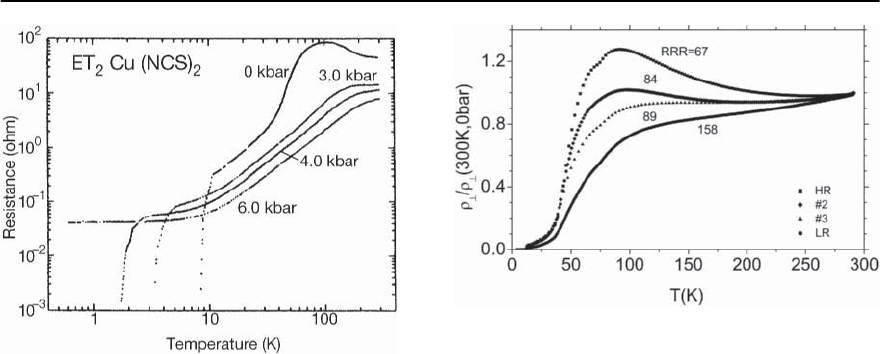
20 Organic Superconductors 1167
Fig. 20.11. Temperature dependence of the resistivity mea-
sured along the in-plane b-axis of -(ET)
2
Cu(NCS)
2
at var-
ious pressures, taken from [78]
tion of temperature at various pressures [78]. With
decreasing temperatures, (T) first increases to a
maximum at around 100 K before a metallic behav-
ior sets in at lower temperatures. Under hydrostatic
pressure, the maximum shifts to higher tempera-
tures and becomes progressively suppressed. This is
accompanied by a significant reduction of T
c
(see
also inset of Fig. 20.9). The origin of the anomalous
(T) hump has been discussed by many authors and
various explanations have been suggested including
the formation of small polarons [83], a metal–metal
phase transition [84], a valence instability of Cu [85],
an order–disorder transition of the terminal ethy-
lene groups of the ET molecules [86–88] as well as a
crossover from localized small-polaron to coherent
large-polaron behavior [89]. In this context it is in-
teresting to note that for the -(ET)
2
Cu[N(CN)
2
]Br
system this maximum has been found to be sample
dependent: using a different synthesis route, Thoma
et al. [90] and Montgomery et al. [91] succeeded in
preparing superconducting crystals which lack the
anomalous resistance hump. Those differently pre-
pared -(ET)
2
Cu[N(CN)
2
]Br crystals have been the
subject of a recent comparative resistivity study [92],
see Fig. 20.12. It has been found that irrespective of
the markedly different resistivity profiles, especially
at intermediate temperatures and in the low-T range
where the resistance decreases quadratically with
Fig. 20.12. Temperature dependence of the normalized in-
terlayer resistivity of various single crystalline samples of
-(ET)
2
Cu[N(CN)
2
]Br . The RRR values denote the resid-
ualresistivityratio
⊥
(300K)/
⊥
(0) withthe residual resis-
tivity
⊥
(0) determined by extrapolating the normal-state
resistivityto T = 0, taken from [92]
temperature ∝ AT
2
, these crystals reveal almost
the same, high superconducting transition tempera-
tures. In the absence of significant differences in the
crystals’ structural parameters and chemical com-
positions, as probed by X-ray and electron-probe-
microanalysis,respectively,theseresults indicatethat
real-structure phenomena such as disorder and/or
defects may strongly affect the inelastic scattering in
these compounds [92].
A closer look on the resistivity of -(ET)
2
Cu(NCS)
2
below the maximum discloses an abrupt
change in the slope at temperatures around 45 ∼
50 K [93]. A similar behavior is found for -(ET)
2
Cu[N(CN)
2
]Br [94] and has been interpreted as a
crossover from a regime of antiferromagnetic fluc-
tuations of localized spins at high temperatures to
alow-T Fermi-liquid regime [95,96]. Within a dy-
namical mean field approach, Merino et al. [97] have
attributed this change in the charge response to a
smooth crossover from coherent Fermi liquid excita-
tions at low temperatures to incoherent (bad metal)-
excitationsat higher temperatures.Using such DMFT
calculationsfor asimple Hubbard model,Limeletteet
al.[98] recently attemptedto provideeven a quantita-
tive description of the whole anomalous (T)behav-
ior for pressurized -(BEDT-TTF)
2
Cu[N(CN)
2
]Cl
covering also the resistivity maximum and the semi-
conducting regime at higher temperatures. Alterna-

1168 M. Lang and J. M¨uller
tively, it has been proposed that the rather drastic
change in the resistivity, which coincides with sharp
features in thermodynamic quantities [92], marks
a cooperative phenomenon such as a density-wave-
type phase transition [99–101], see Sect. 20.3.3 for a
detailed discussion.
At temperatures below the inflection point, the re-
sistivity turns into an approximate (T)=
0
+ AT
2
behavior until superconductivity sets in around 10K.
As mentioned above, a resistivity roughly following
a T
2
law, even at elevated temperatures, is not an
exception in the present molecular conductors, see
e.g. [5]. In some high-quality crystals of ˇ-type and
-type (ET)
2
I
3
, it has been observed over an extraor-
dinarily wide temperature range up to temperatures
as high as 100 K [102].It has been argued that the T
2
dependence of the resistivity indicates a dominant
role of electron–electron scattering in these materi-
als [7]. On the other hand, for such a mechanism to
predominate the resistivity at temperatures as high
as 45 K for the X = Cu(NCS)
2
and even 100 K for
the X = I
3
salt implies that there is only a minor
contribution from electron–phonon scattering. In
light of the considerable electron–phonon coupling
in these materials as proved by various experiments,
such a scenario appears questionable. Alternatively,
the T
2
law has been attributed to the scattering
of electrons by phonons via electron–libron [103]
or a novel electron–phonon scattering mechanism
proposed for the high-T
c
cuprates [102] which in-
vokes electron–electron interactions [104, 105]. For
the discussion of the temperature dependence of the
resistivity, it is important to bear in mind, however,
that due to the large pressure coefficients of the re-
sistivity of about ∂ ln /∂p −20 %/kbar at room
temperature together with the extraordinary strong
thermal contraction,it is difficult to make a compar-
ison with theoretical predictions. Since the theory
usually describes the temperature dependence at
constant volume, a detailed comparison is mean-
ingful only after transforming the constant-pressure
into constant-volume profiles by taking into account
the thermal expansion of the material.
Similar to the quasi-1D (TM)
2
Xsalts,theroom-
temperature resistivities of the quasi-2D (BEDT-
TTF)
2
X materials are generally rather high. For the
-(ET)
2
Cu(NCS)
2
salt for example, one finds
b
≈
6 ·10
4
§cm and
c
≈ 3 ·10
4
§cm [106],which ex-
ceed the values for Cu by several orders of magnitude.
This is partly due to the relatively low charge-carrier
concentration of only about 10
21
cm
−3
.
In accordance with their quasi-2D electronic
structure, a pronounced in-plane vs out-of-plane
anisotropy has been observed which amounts to
10
−3
∼ 10
−5
[40]. In this respect it is interesting to
ask whether under these conditions the interlayer
transport is coherent or not, i.e. whether there is a
coherent motion of band states associated with well-
defined wave vectors or if the motion from layer
to layer is diffusive and a Fermi velocity perpen-
dicular to the layers cannot be defined [107]. This
question has been addressed in recent magnetore-
sistance studies on the -(ET)
2
Cu(NCS)
2
salt [108].
Here the interlayer-transfer integral has been esti-
mated to be t
⊥
≈ 0.04meV [108] as compared with
t
∼ 150 meV for the intralayer transfer [46].Accord-
ingtothiswork,theFermisurfaceisextendedalong
the interlayer direction corresponding to a coherent
transport.
Optical Conductivity
Optical investigations by means of infrared and Ra-
man measurements provide important information
on the electronic parameters such as the plasma fre-
quency, the optical masses and also the bandwidths
and collision times for the carriers. In addition, they
permit an investigationof vibrationalproperties and
their coupling to the charge carriers.Using polarized
light it is also possible to look for anisotropies in
these quantities, as e.g. in the effective masses. The
optical properties of quasi-1D and quasi-2D organic
conductors have been reviewed by several authors
[6,33,109–112], see also [5,10].For a detailed discus-
sion on the normal-state and superconducting-state
optical properties of the (ET)
2
X salts see [113]. A
summary of Raman results on (ET)
2
Xsaltsisgiven
in [114,115].
First extensive optical studies of the electronic
properties of (TM)
2
X by Jacobsen et al. [116] pro-
vided information on the energy of charge-transfer
processes and on the electron–phonon coupling: the
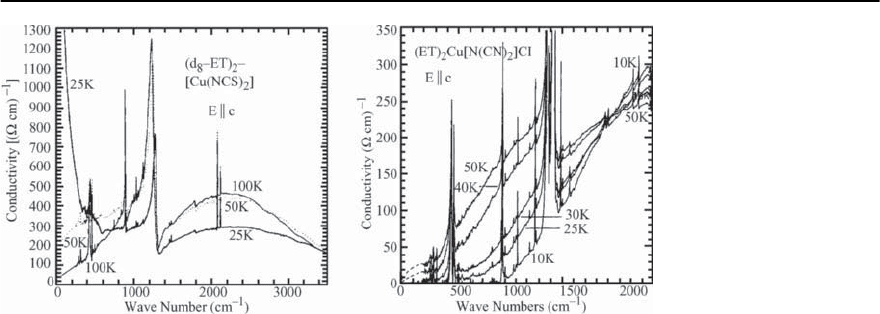
20 Organic Superconductors 1169
Fig. 20.13. Optical conduc-
tivity of -(D
8
-ET)
2
Cu
(NCS)
2
(left panel)and-
(ET)
2
Cu[N(CN)
2
]Cl (right
panel)atvarioustemper-
atures for E c.Taken
from [120] and [121],
respectively
largeabsorption featuresobserved in theoptical con-
ductivity of the TMTTF salts have been assigned to
intramolecular and intermolecular vibrations [117].
These studies have been supplemented by a series
of more detailed investigations covering also the low
frequency range, see [112] and references therein.
In accordance with the expectations for a strongly
anisotropic material with open Fermi surface, the
optical response of the Bechgaards salts (TMTSF)
2
X
was found to deviate strongly from that of a sim-
ple metal. The main features are a gap-like structure
around 25 meV for X = PF
6
and a zero-frequency
mode which grows upon decreasing the temperature.
The latter contribution,having only a small spectral
weight corresponding to 1 % of the carriers, is re-
sponsible for the metallic conductivity of the com-
pound [112]. At high frequencies, i.e. at energies in
excess of the interchain transfer integral t
b
but be-
low the intraband width 4t
a
, the data for the opti-
cal conductivity follow a
1
(!) ∝ !
−
dependence
with =1.3 [112]. Here =4n
2
K
−5,whereK
is the Luttinger-liquid-correlation parameter and n
the degree of commensurability. From the experi-
mentally derived value and assuming n =2,i.e.
a dominant quarter-filled band Umklapp scattering,
K
0.23 has been determined which agrees rea-
sonably well with photoemission [75,118,119] and
transport data [77]. These observations are consis-
tent with a dimensional crossover in (TMTSF)
2
PF
6
from a high-temperature Luttinger-liquid phase to
a low-temperature (anisotropic) 3D Fermi liquid in-
duced by interchain coupling.
For the various ET salts, the reflectance spec-
tra are generally characterized by intensive sharp
features due to molecular vibrations superimposed
on a broad electronic background with the plasma
edge at a frequency of about 4500 ∼ 5000 cm
−1
.
Figure 20.13 shows optical conductivity data of su-
perconducting deuterated -(D
8
-ET)
2
Cu(NCS)
2
(left
panel) and insulating -(ET)
2
Cu[N(CN)
2
]Cl (right
panel) at various temperatures obtained from reflec-
tivity measurements after a Kramers–Kronig anal-
ysis [120,121]. The far-infrared conductivities have
been found to agree reasonably well with the dc-
conductivities in showing a rapid increase below
50 K for -(ET)
2
Cu(NCS)
2
. The low-frequency fea-
ture has been interpreted as a Drude peak which
increases with decreasing temperature or increas-
ing pressure, i.e. when the metallic character of the
material increases. The data are in good agreement
with results of other studies, see [10, 89, 113] and
references cited therein. However, the interpreta-
tion of the spectra may vary from author to au-
thor: Kornelsen et al. attributed the mid-infrared
peak (1000 ∼ 4000 cm
−1
) to interband transitions
superimposed on the free-carrier tail [120]. Wang et
al. [89] argued that the sharp Drude peak in the con-
ductivity that develops at low temperature, together
with the large mid-infrared spectral weight indicate
polaronic effects. According to this interpretation,
the change from non-metallic to metallic behavior
around 90 ∼ 100 K as observed in the resistivity
is due to a crossover from localized small-polaron
to coherent large-polaron behavior [89]. In contrast
